Scotland's Carers
This report brings together statistical analysis and research on caring. The report is intended to provide a useful source of information for carer's organisations, policy makers, local authorities and anyone who is a carer or knows someone who is a carer.
This document is part of a collection
1. Chapter 1: Who Provides Care in Scotland?
- There are an estimated 759,000 carers aged 16+ in Scotland - 17% of the adult population
- There are an estimated 29,000 young carers in Scotland - 4% of the child population (aged 4-15)
- There are estimated to be over 171,000 carers aged 16+ caring for 35 hours a week or more
1.1. Introduction
There are around 759,000 adults, 17% of the adult population aged 16 and over in Scotland, providing care to one or more people. This chapter presents the latest data from Scotland's 2011 Census and the Scottish Health Survey (SHeS) 2012/2013 (see section 1.3 for explanation of these data sources) to show the diverse profile of carers in Scotland including;
- Who are the carers, by age, gender, ethnic origin, relative deprivation, family situation and where they live.
- Hours of care provided and the length of time they have been caring.
1.2. Background
These figures are derived from robust survey data collected by the Scottish Government and are considered the most accurate available for the number of carers in Scotland in 2012/2013. They are derived from robust survey data collected by the Scottish Government but need to be understood in light of factors in gathering data on carers. Whilst method, design and the nature of the population can affect the data in social surveys there are known to be issues relevant, but not unique, to carers. Research has found it can be difficult to identify people who are carers. Research with carers has revealed a main reason for this to be:
- Often people providing care do not self-identify as a carer or with the term because they see their relationship is as a relative, maybe a child, or friend to which the caring activities are an integral dimension (Carduff, et al., 2014; (Smyth, et al., 2011).
- Women are more likely than men to view tasks as integral to their existing role rather than as separate "caring" (Jarvis & Worth, 2004).
- Often caring commences at a low level and can include "invisible tasks" such as giving the cared for person; "emotional support, monitoring their situation and worrying about them" (Jarvis & Worth, 2004) which are less recognised that the tangible caring tasks. More people come to identify as a carer when caring intensifies, which is common, and at key junctures such as giving up employment to care (Carduff, et al., 2014).
- Acceptance of the identity of care necessitates acknowledgement that the other person needs care which can be difficult for one or both parties to do (Carduff, et al., 2014).
1.3. Estimating number of carers and hours of care provided
The Scottish Health Survey shows that 17% of the adult population (aged 16+) are carers. For all the reasons set out this provides our best estimate of the number of carers in Scotland.
The Scottish Health Survey (SHeS) estimates are based on a statistically drawn sample, with survey weights applied to reflect the population age distribution across Scotland and in Scottish areas. Taking into account the stratified and clustered sample design and scaling to population estimates, 95% confidence limits around the estimated number of carers aged 16+ in Scotland are [714,000; 804,000].
SHeS provides what we consider to be the best estimate of the number of people caring in Scotland at the present time. SHeS asks whether anyone in the household looks after or gives any regular help or support to family members, friends, neighbours or others because of either long-term physical / mental ill-health / disability; or problems related to old age. The SHeS provides estimates for carers aged 4-15 and 16 and over and these groups are reported here. However in practice young carer are considered to be those aged up to 18 years and indeed younger adult carers are considered to be aged 18-25 (Scottish Government, 2010b).
For adults aged 16+, SHeS for 2012 and 2013 shows:
- 83% said that they did not provide any unpaid care
- 5% said they provided up to 4 hours of care a week
- 8% said they provided 5-34 hours of care a week
- 3% said they provided 35 or more hours care a week
- 1% said the amount of care they provided varied from week to week
Figure 1: SHeS 2012 / 2013 - Estimated 759,000 carers aged 16+
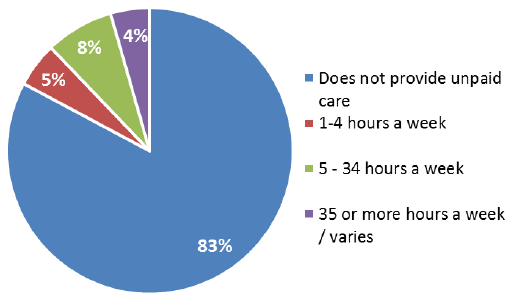
Source: Scottish Health Survey 2012/2013; NRS population estimates
Scotland's 2011 Census shows that
- 9.3% of the population are carers
- 11% of the adult population (aged 16+) are carers
- Over 171,000 people aged 16+ said they provided 35 or more hours care each week
Scotland's 2011 Census is thought to underestimate the extent of low level caring for reasons set out in this chapter but provides a good estimate of people with substantial caring responsibilities
For all the reasons set out in this chapter, this provides our best estimate of the number of carers in Scotland.
Scotland's 2011 Census also provides information on the number of people in Scotland who identify themselves to be carers. In the Census, people were asked if they look after or give any help or support to family members, friends, neighbours or others because of either: long-term physical or mental ill-health or disability; or problems related to old age.
Overall:
- 4,803,000 people said they provided no care (90.7%); while
- over 492,000 people said that they did provide care (9.3%)
Of those that said that they provided care:
- Over 273,000 people said they provided 1-19 hours care a week (5.2% of the population)
- Over 46,000 people said they provided 20-34 hours care a week (0.9%)
- Over 172,500 people said they provided 35 or more hours care a week (3.3%)
For adults aged 16+
- 3,897,000 people said they provided no care (89.0%)
- Over 482,000 people said that they provided care (11.0%)
Of those that said that they provided care:
- Nearly 266,000 people said they provided 1-19 hours care a week (6.1% of the population)
- Over 45,000 people said they provided 20-34 hours care a week (1.0%)
- Over 171,000 people said they provided 35 or more hours care a week (3.9%)
Figure 2: Scotland's 2011 Census - 482,000 carers aged 16+
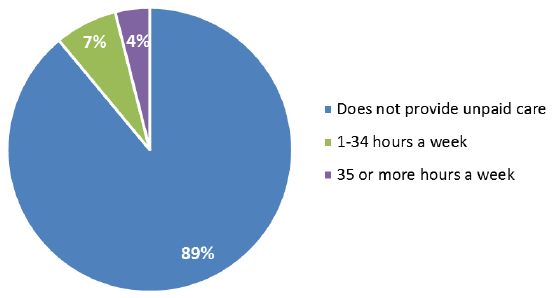
Source: Scotland's Census 2011
In this publication some analyses will relate to the SheS 2012/2013 estimate (759,000 carers) while more detailed analyses will tend to relate to data from Scotland's 2011 Census (482,000 carers). The text and source information should make it clear which source is being used.
1.4. Comparing findings from the SHeS and Census 2011
It is useful to consider why these two sources differ so much. The main difference appears to be for carers who care for only a few hours per week. These carers are more likely to have been identified in the SHeS.
One reason that we get different answers from different surveys is because often people don't recognise themselves as a carer but simply as someone who is looking after their family and friends.
Scotland's 2011 Census and the 2012/2013 SheS ask identical questions so it might be reasonable to expect a similar response. However, the 2011 population census is a postal survey and generates a much smaller response to the caring question (492,000 carers) than the SHeS (788,000 carers) which is an interview survey.
There are a number of reasons why these differences may occur:
- In the SHeS each adult in the household is personally asked the carers' question. Therefore each adult speaks directly to the interviewer and says whether they provide care and how many hours a week.
- In Scotland's 2011 Census, it may be the case that one person will answer the questionnaire for the whole household. This person may not be aware of caring activity going on elsewhere in the household or may feel uncomfortable explaining that someone else in the household provides care for them.
- Because the SHeS is an interview survey it allows the respondent to ask for clarification if they don't understand the question. There is not this opportunity with a postal survey.
- The SHeS question is asked as part of a detailed health survey and follows a block of questions about long-term conditions which means that people will be thinking more about health and care issues when they answer the question.
- The SHeS has an additional category asking if people provide care for up to 4 hours each week whereas the first category in Scotland's 2011 census is "up to 19 hours of care" a week. It may be that the large number of hours in the census category deters people who only provide a small amount of care from answering.
For all of these reasons, the SHeS is considered to provide the best estimate of the overall number of carers in Scotland. Both sources provide similar results when looking at carers who do substantial amounts of caring each week and the Census figure of 171,000 has been used as a best estimate of adult carers who care for 35 or more hours each week.
Both Scotland's 2011 Census and the 2012 and 2013 SHeS provide similar estimates of the number of carers who are caring for 35 or more hours a week. Scotland's 2011 Census shows that 4% of the population said they cared for 35 hours a week or more while the SHeS shows that around 4% of the population said that they cared for 35 hours a week or more or that their caring varied from week to week. 35 hours a week is a significant amount of time, equivalent to the number of hours in a full-time working week, so it is perhaps unsurprising that these people are more likely to identify as carers in both surveys. SHeS estimates that around 140,000 people are caring for 35 or more hours each week. In addition it is estimated that a further 54,000 people provide care that varies a lot from week to week. Taking both of these figures into account and the Census 2011 figure of 171,000 people aged 16+ caring for 35 hours a week or more leads to conclude that there are over 171,000 carers aged 16+ caring for 35 hours or more a week.
Scotland's 2001 and 2011 Censuses underestimate the number of people providing small amounts of care each week and this should be borne in mind when considering any of the census analysis presented in this publication.
Scotland's 2001 and 2011 Censuses do however provide a good estimate of the number of carers who provide substantial levels of care and support each week. Being a full census, they also allow for more in-depth analysis of carers and allow for analysis at Local authority level.
1.5. Are Scotland's carers increasing or decreasing in number?
- Small increase in number of carers from 480,000 people in 2001 to 492,000 people in 2011
- Small decrease in proportion of population who provide care between 2001 and 2011 - from 9.6% to 9.3%
- Increase in the number of people who care for 50 hours or more a week - from 24% of carers in 2001 to 27% in 2011
- Increase in the number of people who care for 20-49 hours a week - from 13% of carers in 2001 to 18% in 2011
A question on caring was asked in Scotland's 2001 and 2011 population censuses and this allows comparison of how many people identified themselves as carers at each census point and how this has changed over the ten year period.
Figures 3 and 4: Intensity of Care provided, 2001 v 2011
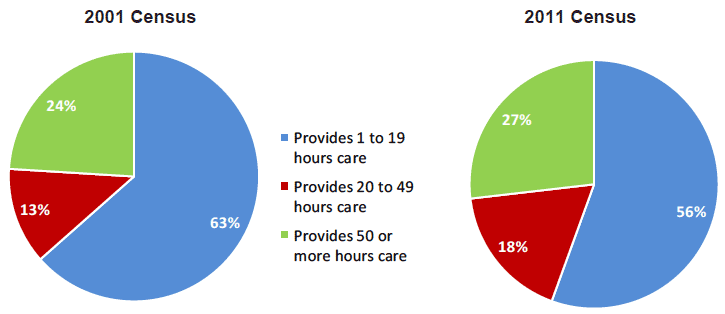
Source: Scotland's Census 2011
There has been a slight increase in the number of people identifying as carers over the 10 year period but at the same time there has been a small decrease in the proportion of the population who say that they provide care.
The main change has been in the number of hours of care provided each week.
- In 2001, there were over 115,000 people who said they provided 50 or more hours of care each week (24% of carers). By 2011, this had increased to over 132,000 (27% of carers).
- In 2001, just over 60,000 people said that they cared for 20-49 hours per week (13% of carers). In 2011 this had increased to nearly 87,000 people (18% of carers).
1.6. Age, gender and ethnicity of carers
- Overall 41% of carers are men; and 59% are women
- The age group someone is most likely to be a carer is 55-64 years old
- Working age women are much more likely to be carers than men
The SHeS shows that overall 41% of carers are male and 59% are female.
SHeS shows that the likelihood of being a carer increases with age, up until ages 55-64. Around 12% of women and 9% of men in their 20s and early 30s are carers but for those in their late 50s / early 60s nearly a third of women are carers as are over a fifth of men. Throughout the working years, women are more likely to be carers than men. This is particularly true for the 35-44 age group when women may also have school-age or pre-school children to look after.
Following retirement age, the difference between men and women balances out with 19% of both men and women in the 65-74 age group providing care. Looking at the older age groups men become more likely to be carers - 12% of men aged 75+ say they are carers compared with 9% of women.
Figure 5: Age and gender of carers, 2012/2013
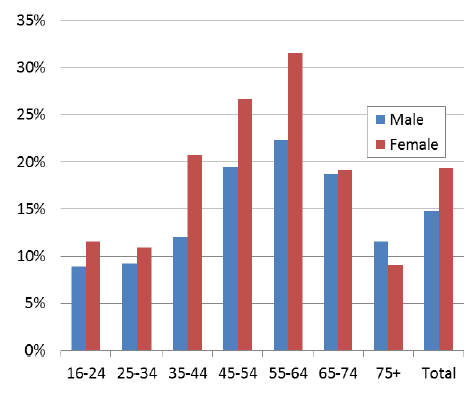
Source: Scottish Health Survey 2012/2013
Figure 6: Age and gender distribution of carers in Scotland, 2011
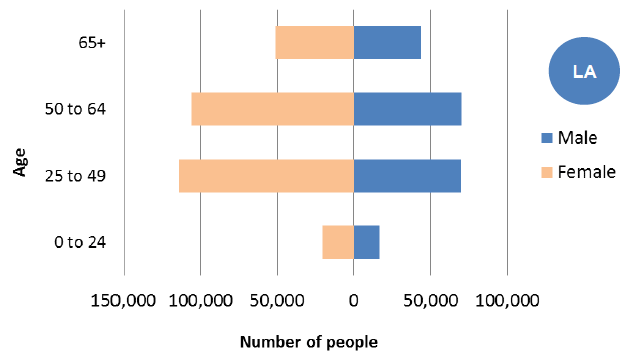
Source: Scotland's Census 2011
Scotland's 2011 Census shows the same picture, that overall 41% of carers are male and 59% are female. This varies for different life stages:
| Aged under 25 years |
Aged 25-49 years |
Aged 50-64 years |
Aged 65 and over |
|---|---|---|---|
|
|
|
|
|
|
|
|
Scotland's 2011 Census, allows us to look in more detail at the amount of caring that different age groups provide.
- The 50-64 age group is the most likely to provide care: nearly 17% of people in this age group said they provided care
- Over half of older carers (aged 65 and over) provide 35 hours of care a week or more compared with just over a fifth of young carers aged under 24.
Figure 7: Level of care per week, by age group (all people), 2011
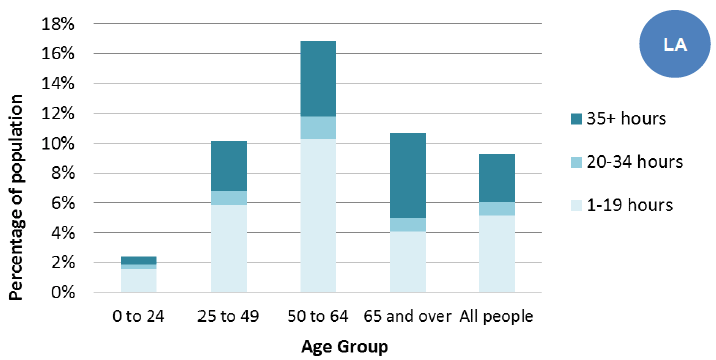
Source: Scotland's Census 2011
Figure 8: Level of care per week, by age group (all carers), 2011
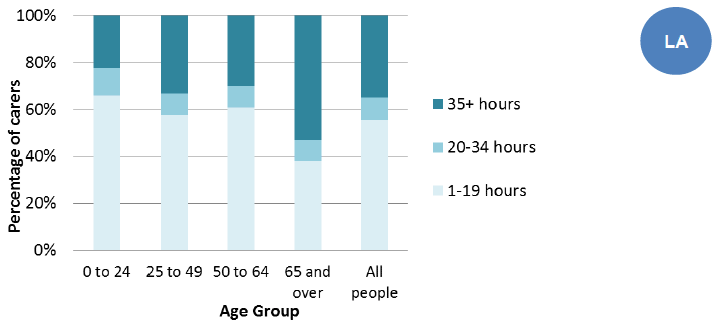
Source: Scotland's Census 2011
Scotland's 2011 Census tells us about carers' ethnicity. Overall 9% of the white Scottish / British / Irish population are carers compared to 5% of other ethnicities. Further work is needed to look at the age structure and health of different ethnic populations to see if that explains some or all of this difference.
Further information on carers and ethnicity is also available from "Analysis of Equality Results from the 2011 Census" published by the Scottish Government in 2014. Chapter 1 considers ethnicity in more detail: http://www.gov.scot/Publications/2014/10/8378/3 and shows that:
- People from older ethnic groups such as 'White: Scottish' and 'White: Other British' were the most likely to provide unpaid care.
- People from ethnic groups with younger age profiles (such as the 'Arab' and 'White: Polish' groups) were least likely to provide unpaid care.
Figure 9: Percentage of all carers who are from an ethnic minority background, 2011
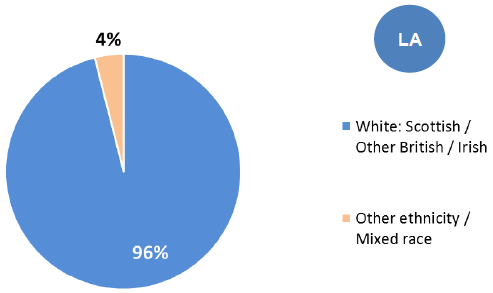
Source: Scotland's Census 2011
Figure 10: Ethnic group and level of care per week provided by carers, 2011
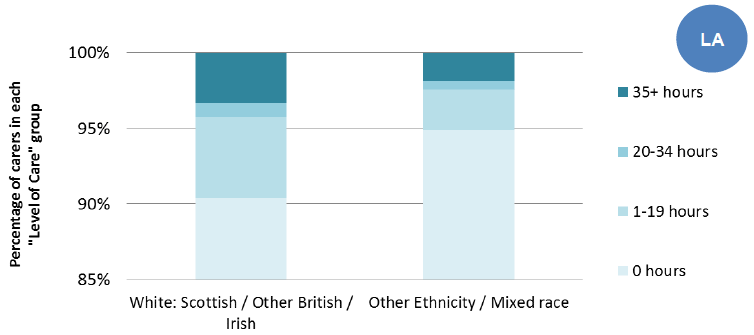
Source: Scotland's Census 2011
1.7. Length of time spent caring
- 14% of carers had been caring for less than a year
- 46% of carers had been caring for 5 years or more
- 6% of carers had been caring for 20 years or more
The SHeS 2012/2013 asks people how long they have been caring.
Overall:
- 14% of people had been caring for less than 1 year;
- 40% had been caring for between 1 and 5 years;
- 26% had been caring for between 5 and 10 years;
- 14% had been caring for between 10 and 20 years; and
- 6% had been caring for more than 20 years.
Figure 11: Length of time spent caring, 2012/2013
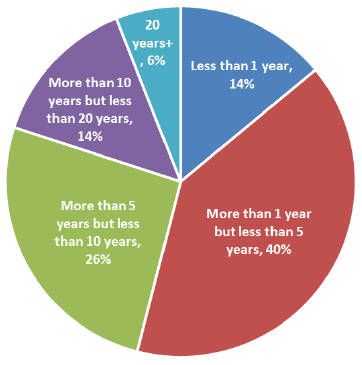
Source: Scottish Health Survey 2012/2013
1.8. Caring relationships
- Children living with a lone parent were more likely to be carers (6.6% are carers) than children living with two parents (2.5% are carers)
- 78% of carers were in a couple
- 4% of families with pre-school children included a carer; rising as children got older to 14% of families with no dependent children
Unfortunately Scotland's 2011 Census cannot tell us who each carer cares for. Carers may care for more than one person and people may have more than one carer so the relationships can be very complex.
People may care for someone within their household and the Census 2011 disability questions allows us to identify people in households who may require care. It could be assumed that other members of the household who say that they provide care are caring for this person, though caution should be exercised in this interpretation. Where this is most likely to be true is in the case of child carers who are more likely to be caring for someone in the same household.
Scotland's 2011 Census shows that children who live with a lone parent are much more likely to be a carer (6.6% are carers) than a child who lives with two parents (2.5% are carers).
Children who live with a lone parent are also much more likely to have substantial caring responsibilities (35 hours or more a week) than children living with two parents. Scotland's 2011 Census shows that nearly 3% of children living with a lone parent are caring for 35 hours a week or more while only 0.5% of children living with two parents provide this level of care.
Over 429,000 carers live with family rather than on their own or with people they are not related to (e.g. student household). Scotland's 2011 Census provides information on the different type of family situations that exist and the likelihood of being a carer for each of these.
In Scotland's 2011 Census,
- 78% or nearly 336,000 carers were in a couple this includes couples with or without children
- 9% or nearly 40,000 carers were a lone parent
- 7% or nearly 29,000 carers were the child of a lone parent; this can include adult children who live with a parent
- 6% or 25,000 carers were the child of a couple; including adult children who live with their parents
These figures explain the relationship within the household that the carer lives but that does not necessarily infer the caring relationship that they do. For example, a member of a couple does not necessarily care for their partner. Also a member of a couple could be living with one or more children or other relatives who they may or may not care for.
Figure 12: Family status of carer (people in families only), 2011
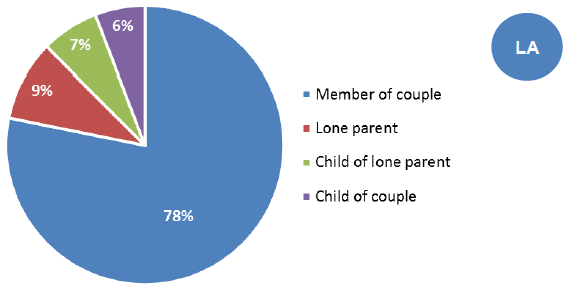
Source: Scotland's Census 2011
Data from Scotland's 2011 Census shows that couples and lone parents are equally likely to be carers but lone parents are more likely to care for 20 hours a week or more. This makes sense as couples are more likely to be able to share the caring role.
Also a child living with a lone parent is much more likely to be a carer than a child living with a couple (note that this will include adult children who still live with their parents). Again this is not surprising as a child living with a couple is more likely to have support to provide care.
Figure 13: Family status of carer and level of care per week, 2011
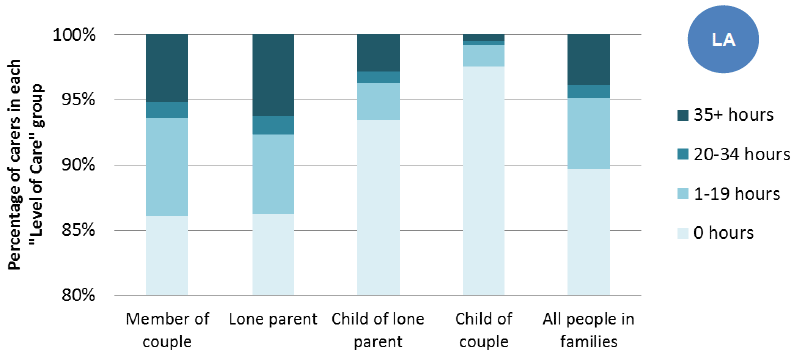
Source: Scotland's 2011 Census - 429,330 carers (excludes carers who live alone)
Scotland's 2011 Census tells us about the family situation of carers and whether there are any children living in the family. Families with pre-school children are the least likely to include a carer in the family - only 3.9% say that they are carers. However the likelihood of being a carer increases as children get older and is most likely for family situations where there are no dependent children. This could be older couples caring for parents or older couples caring for each other.
- 4% of families with pre-school children included a carer in the household;
- 7% of families with primary school age children;
- 10% of families with secondary school age children;
- 14% of families with no dependent children;
Figure 14: Carers who have dependent children, by level of care per week, 2011
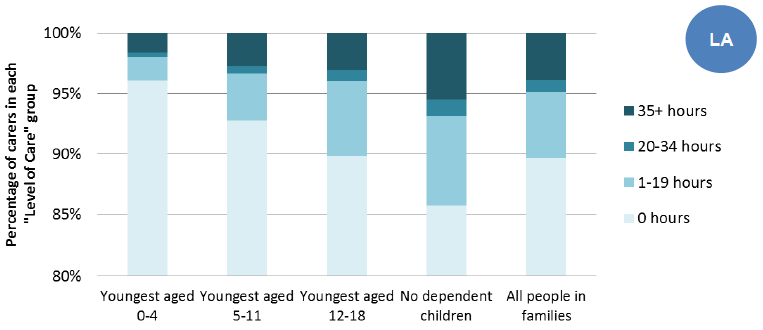
Source: Scotland's 2011 Census- 429,330 carers (excludes carers who live alone)
1.9. Young carers
- There are an estimated 29,000 young carers aged 4-15 in Scotland
- It can be difficult to identify young carers; Scotland's 2011 Census identified just over 10,000 young carers aged under 16
- In 2014, schools in Scotland identified nearly 1,200 school age children with additional support needs because they are young carers
The SHeS estimates that 4% of children aged 4-15 are carers. Taking into account the sample design and scaling to population estimates, 95% confidence limits around that estimate are [22,000; 36,000].
While the SHeS provides the best estimate of overall numbers of young carers aged under 16, the sample size does not allow for analysis of these young carers in any more detail. Scotland's 2011 census, while underestimating what we understand to be the true level of young caring does allow for more detailed analysis of the young carers who self-identified.
Just over 10,000 young people aged under 16 identified themselves as carers in Scotland's 2011 census:
- Over three-quarters, 7,660 children said that they provided care for up to 20 hours a week
- 10% said that they provided care for 20-34 hours per week (just over 1,000 children)
- 13% said that they provided more than 35 hours of care a week (over 1,300 children)
Figure 15: Young carers aged under 16; by intensity of care provided, 2011
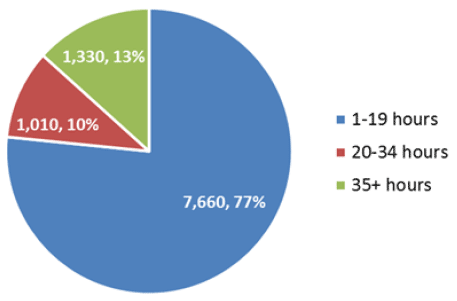
Source: Scotland's Census 2011
Young carers are difficult to identify in the census, particularly because the census form will often be completed by the main householder who is likely to be an adult and may also be the person that the child provides care to.
The census is likely to pick up carers who are already known to carers' centres and to schools and those who are doing substantial amounts of care but may not give a good indication of the level of caring which is not known to local authorities or schools.
The Scottish Health Survey (SHeS) estimates that there are around 29,000 young carers aged under 16 in Scotland. This is three times the number who are identified as carers in the Census. Section 1.4 explains why the SHeS provides a better estimate of the number of carers.
Scotland's 2011 Census shows that the both the number and proportion of children who say they provide care rises with each year of age. Only 160 (0.3% of) 5 year olds are identified as providing care and this increases with each year of age up to 2,840 (4.4% of) 17 year olds.
Figure 16: Number of young carers (aged 5-17), 2011
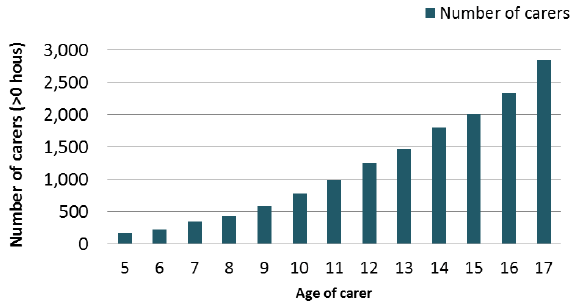
Source: Scotland's Census 2011
Figure 17: % of young people (aged 5-17) providing care, 2011
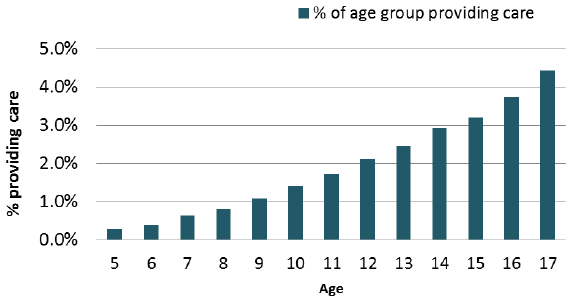
Source: Scotland's Census 2011
Scotland's 2011 Census shows that the number of students who say that they are carers, declines with each year of age. There were 1,470 18 year old students who said that they provided care and this is nearly 4% of the 18 year old student population. Students aged 21 were the least likely to be providing care: just under 3% of 21 year old students provided care. Further research would be needed to determine the reasons for this and whether young people are giving up caring in order to study or giving up their study in order to care.
There are a larger proportion of student carers with each year of age from 21 onwards. Further research could be done to see if student carers take longer to get their degree or switch to part-time courses to accommodate their caring responsibilities.
Figure 18: Number of students aged 18-24 providing care, 2011
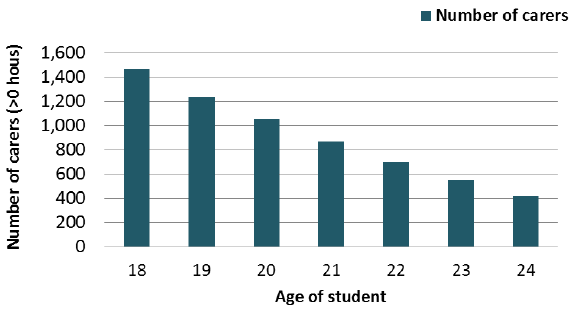
Source: Scotland's Census 2011
Figure 19: % of students aged 18-24 providing care, 2011
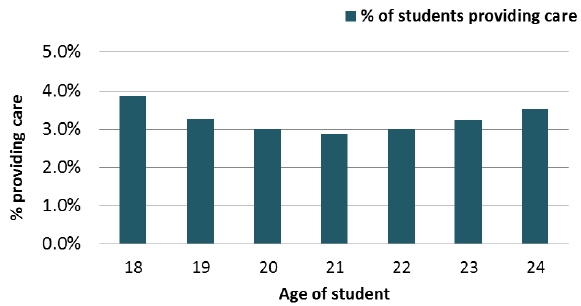
Source: Scotland's Census 2011
1.10. Scottish Index of Multiple Deprivation
- Overall, the proportion of people who are carers shows little difference between the least and most deprived areas
- 47% of carers living in the most deprived areas care for 35 hours a week or more; compared with 24% of carers living in the least deprived areas
- 3.1% of people aged under 25 living in the 20% most deprived areas in Scotland are carers compared with 1.7% in the least deprived areas
- 28% of young carers in the most deprived areas care for 35 hours a week or more; compared with only 17% of carers in the least deprived areas
Scotland's 2011 Census allows us to look at carers and where they live in Scotland categorised according to the Scottish Index of Multiple Deprivation (SIMD). The SIMD ranks the 6,505 datazones that cover Scotland from most deprived (ranked 1) to least deprived (ranked 6,505). These datazones can then be split into five quintiles with SIMD1 including the 20% of datazones that are most deprived up to SIMD5 which contains the 20% of datazones that are least deprived.
The proportion of people who say they are carers varies very little between the most deprived datazones and the least deprived datazones. Variation ranges from 9.3% in the least deprived datazones (SIMD5) to 9.6% in SIMD2.
Figure 20: Proportion of carers in each deprivation quintile, 2011
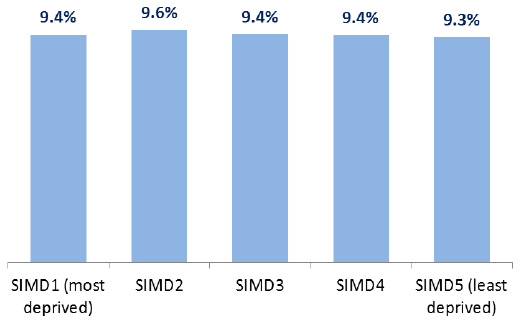
Source: Scotland's Census 2011
Scotland's 2011 Census shows the intensity of care that carers provide each week. This does vary with deprivation:
- 47% of carers in the most deprived areas care for 35 hours a week or more. This is almost double the level in the least deprived areas where only 24% of carers care for 35 hours a week or more. The chart shows a linear increase in the percentage caring for 35 hours or more with increasing deprivation.
- 41% of carers in the most deprived areas care for under 20 hours a week. This compares with 68% of carers in the least deprived areas.
Figure 21: Intensity of caring in each deprivation quintile, 2011
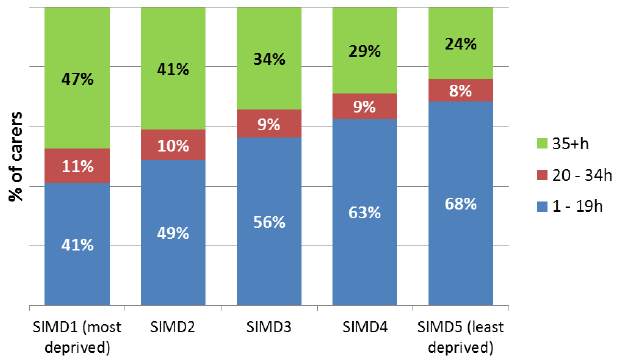
Source: Scotland's Census 2011
Scotland's 2011 Census shows that 3.1% of younger people (aged under 25) living in the 20% most deprived areas in Scotland are carers compared with 1.7% of younger people in the least deprived areas.
Figure 22: Percentage of population aged under 25 who are carers, 2011
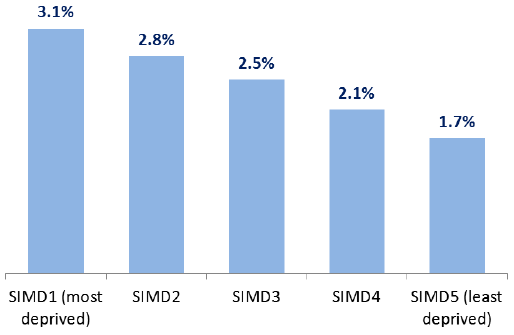
Scotland's 2011 Census shows the intensity of care that these younger carers (aged under 25) provide:
- 28% of younger carers in the most deprived areas care for 35 or more hours each week; this compares with only 17% of carers in the least deprived areas.
Figure 23: Younger carers aged under 25: Intensity of caring each week, 2011
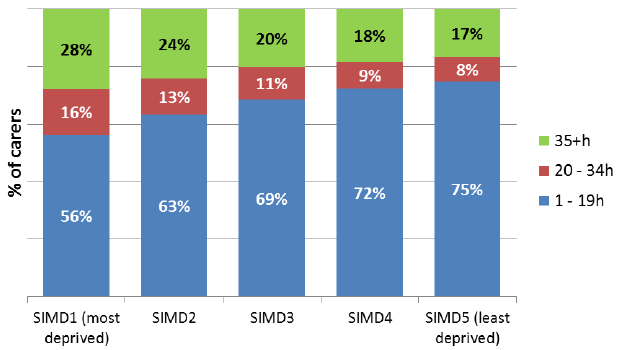
1.11. Conclusion
Here we see the diversity of carers and their circumstances. Whilst a snapshot has found that 17% of the population in Scotland are caring, the number of us that will do so in a lifetime will be far higher. Caring intensity is on a spectrum; with most carers providing up to 20 hours; a quarter 20-49 hours and almost 20% over 50 hours. Most carers are women, but so too are many men; people of all ethnicities and ages contribute to caring. Carers are in all social groups but it is those in the most deprived areas that provide the most hours of caring. Young carers are more common in lone parent families and also contribute the most hours. The remainder of this report looks closer at carers, their welfare and needs and how they can be supported.
Contact
Email: Steven Gillespie
There is a problem
Thanks for your feedback
